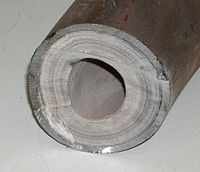
Photo from wikipedia
Abstract Tap water in Kazakhstan is rich in carbonate due to contamination of surface water and insufficient drinking water treatment. This leads to scaling in home appliances such as cooking… Click to show full abstract
Abstract Tap water in Kazakhstan is rich in carbonate due to contamination of surface water and insufficient drinking water treatment. This leads to scaling in home appliances such as cooking ware. Fermented whey is a by-product of small-scale farming, and is rich in lactic acid, with a pH ~ 2.8. Thus, it can be used to formulate a low-cost, environmentally friendly descaling agent. In this work, mild steel coupons were scaled through carbonate precipitation in boiling water. Scale removal with immersion in fermented whey, DI water, and food-grade vinegar was then carried out and monitored through electrochemical analysis and scanning electron microscopy (SEM). While both fermented whey and vinegar removed the fouling layer, they caused pitting corrosion after prolonged immersion. The corrosion potential and current for mild steel coupons in 0.1 M KCl changed from −360 ± 26 mV and 49.3 ± 11.8 µA to −652 ± 1 mV and 16.2 ± 3.8 µA, upon scaling, indicating partial protection from corrosion and the formation of a non-conductive carbonate layer. Following treatment with fermented whey for 3 h, the corrosion potential increased to −427 ± 11 mV, indicating a significant removal of the scale layer comparable to that obtained with commercial vinegar. However, the corrosion current increased only slightly to 24.7 ± 6.2 µA, indicating that the fermented whey treatment did not cause rapid corrosion of the coupons. SEM images confirmed the removal of scale layer upon treatment with fermented whey, relative to the control coupons treated with DI water. These results show that fermented whey can be used as environmentally friendly descaling agent. However, prolonged treatment with whey causes damages to the steel surface and a corrosion inhibitor must be included in the formulation. The availability of whey in small farming communities, in addition to the simple and low-cost methodology outlined here, show promises for practical application and adoption of this green technology in rural areas.
Journal Title: Arabian Journal of Chemistry
Year Published: 2021
Link to full text (if available)
Share on Social Media: Sign Up to like & get
recommendations!